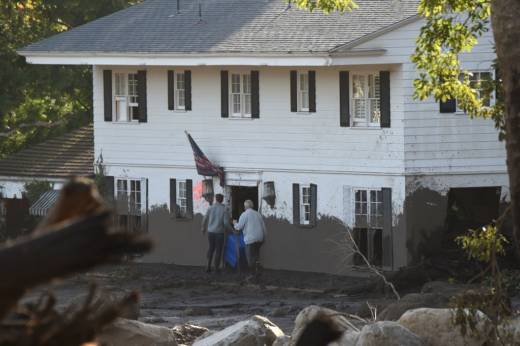The unexpected intensity of the storm is part of what made it so deadly. “Nowhere in my mind did I think it was going to be as bad as it was certainly,” said Jayme Laber, a hydrologist with the National Weather Service.
The storm dropped nearly an inch of rain in 15 minutes in the Montecito area. That’s four times the amount of rain needed to trigger mud and debris flows from the Thomas Fire burn area, Laber said. “That was a really rare rainfall,” he said. “That was something you’d typically see once in 200 years.”
Santa Barbara County officials had been discussing the risk of mudslides in the burn zone since December. In the days before the storm, they set up two evacuation areas in Montecito: a smaller mandatory zone of 7,000 residents and a much bigger voluntary zone for 23,000 people.
They got the word out on social media and in meetings. And then on Monday, sheriff's deputies went door to door in the mandatory area telling people to leave. But a county spokeswoman said most people stayed behind.
“You did not have a lot of people who adhered to our evacuation order,” said Amber Anderson, a public information officer for Santa Barbara County.
There are a number of reasons why, some of which have to do with this particular incident and some of which are more about mudslides in general.
The threat from mudslides can be hard to comprehend because a lot of factors play into how deadly they can be, said Sue Perry with the U.S. Geological Survey.
“How intense the rain is to trigger a debris flow varies from place to place. It depends on what exactly the rock is made of, how steep the slope is, how badly that particular area was burned,” she said. “That’s pretty arcane stuff.”
Even the words we use add to the confusion. Perry calls the phenomena “debris flow,” whereas most of us use the term “mudslide,” which sounds less threatening.
Adding to the danger, mudslides also happen very quickly. Dennis Staley, who studies mudslides and debris flows for the USGS, said they can begin within minutes of the start of a heavy rain, “which makes them very difficult not only to predict when they’re going to happen, but it makes it very difficult also to get out of the way.”
USGS developed maps of where mudslides were likely to originate in the Thomas Fire burn area, but Staley said it was very hard to guess how far they'd flow, especially once mud, boulders, debris and water enter an urban environment like Montecito.
Many Montecito residents may have also have simply been tired of evacuating following the Thomas Fire, which raged throughout December, forcing tens of thousands from their homes. They may have been less willing to do so again for a more abstract threat like a mudslide.
“There’s disaster burnout in that community. They just have had to evacuate their homes,” said Deborah Glik, a professor with the Fielding School of Public Health at UCLA who studies disaster communication.
But Gretchen Horn said she chose to stay in her home, which was in a voluntary evacuation area, not because she was tired of leaving, but because she simply didn’t think the mudslides were going to be as disastrous they were. The Thomas Fire felt scary at the time, with ash raining from the sky and the fire engines parked in every driveway during the days when the wind-driven flames and embers threatened Montecito. But looking back, she said, she and her family actually had plenty of time to prepare and evacuate.
“We had days and days and days, and this just decimated entire neighborhoods in 30 seconds.”
